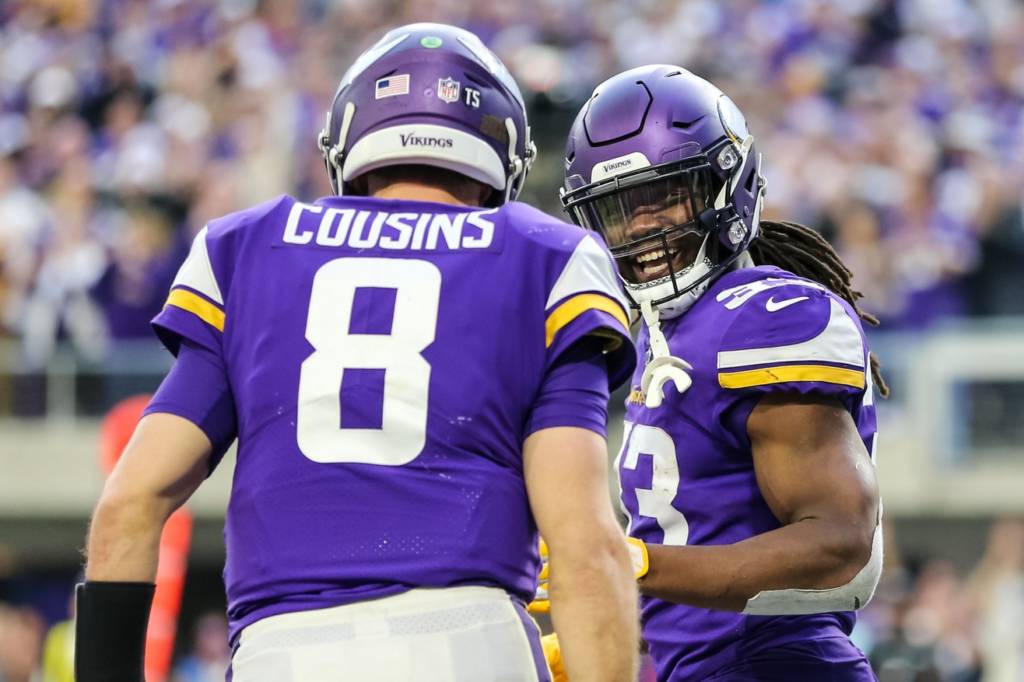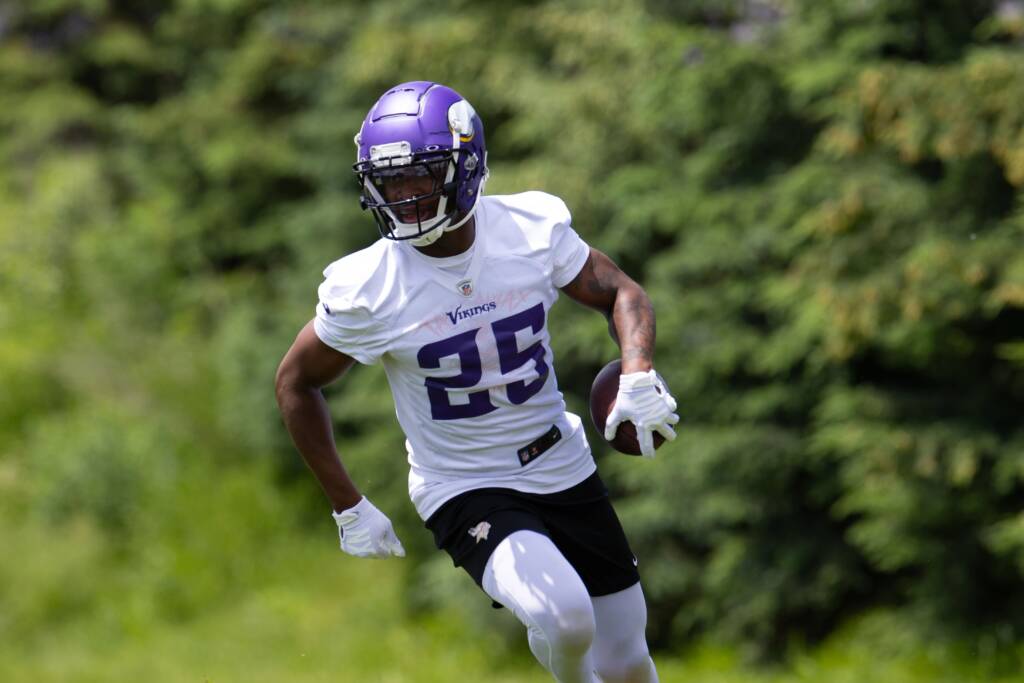A couple weeks ago, we looked into Kirk Cousins and the Minnesota Vikings’ offensive collapse in their two games against the Green Bay Packers last season. Each game had its separate reasons for being a disaster, ranging from shoddy offensive line play to the Packers’ suffocating press coverage. In large part, the article looked at what the Vikings tried to do and why it failed.
Amidst all the trial and error, the Vikings all but abandoned one core part of their offense in both Packers games: running back screens. Football Outsiders’ data credits Minnesota with 41 running back screens on the year. That was good for second-most in the league behind the Cleveland Browns. On those 41 running back screens, the Vikings earned a 72.3% DVOA, trailing only the New England Patriots.
By my count, however, only two of those 41 running back screens were in the two games against Green Bay. And neither of them were from under-center formations, which is significant because Minnesota ran over 70% of all their plays from under center a year ago.
[videopress eJb4UBeh] [videopress AUk3Zxbk]The two situations in which the Vikings called screens against the Packers were not really anything other than desperation. In the Week 2 game, the lone screen was called on a 3rd-and-12. Running back Dalvin Cook fell just a yard short of the conversion, but the result of the play was little more than hoping Cook could make a play — and to be fair, he nearly did.
Week 16’s call was on 2nd-and … wait for it … 24! That is not playing to the tune of an offense. That is admitting defeat on a drive and trying to get out of it without a forced turnover, and rightfully so.
To be fair, the Packers finished the year as one of the best defenses in stopping running back screens. Per DVOA, only five teams held up better. Perhaps that held no relevance in the Week 2 match since there was little film on the Packers defense to that point. For the Week 16 game, however, Green Bay’s stout anti-screen game in addition to the Vikings being down to backup running backs could make sense of why Minnesota avoided those plays almost entirely.
One has to imagine the Vikings still could have at least tried to fit in another screen or two, especially early on in games when they are more likely to be under center due to neutral game states. To that end, let’s go over a few basic screen archetypes to keep an eye out for on Sunday. There are an endless number of ways to run screens depending on back alignment, formation, pre-snap movements, etc., but the three overarching themes you will see are: vertical clears, horizontal clears, and throwbacks.
Vertical Clear
Sorry to bore, but this is exactly what it sounds like. The eligible receivers to the intended screen side will all run vertical stems; often straight verticals, but sometimes branching off into deep posts, corners, benders, and all that good stuff. If all goes well, there should be a bit of a runway for the offensive line and running back to work with around the hash-to-numbers area in which the linebackers, nickel defenders, safeties, etc., have vacated. This is especially effective versus defenses that love running man or match coverages.
[videopress 42U0znTq]Here is an example versus Detroit that went for a modest gain. The Vikings are in a 3×1 “nub” set, meaning a lone tight end attached to the line of scrimmage is opposite the other three receivers. If you pay attention to any Seattle Seahawks game, you will see many of these formations. All three receivers on the left side get vertical until at least 10 yards, opening up an open space for Alexander Mattison to work some 1-on-1s in space. After a sick hurdle over a Lions defender, Mattison is able to cruise to the sticks and pick up a fresh set of downs.
Horizontal Clear
Again, this is exactly what it sounds like. Rather than buying space by forcing defenders to drop with or carry deep route stems, horizontal clears will drag a player across the formation to the opposite side of where the screen is intended to be ran. Generally, it will be the slot receiver to the screen side because the linebacker, safety, nickel, etc., apex defender will most likely be responsible for that slot player and will carry them across the formation, even if just for a few steps to pass them off to the next man. For teams with slower or lower-quality linebackers, this can be a bit tricky to defend.
[videopress MEjsj9Rp]In this clip, the Vikings bring their slot receiver across the formation on a drag route. Though the nickel defender immediately passes it off, the linebacker between the hashes has to begin carrying the drag route across the formation. By the time the linebacker realizes he has been duped, the Vikings have a caravan of offensive linemen leading the way into the nickel defender. This particular linebacker — Ryan Connelly (55) — does not have the redirection or raw speed to make up the ground and get there in time to choke the “running” lane with the nickel. From there, Cook had no issues speeding to the third level, destroying a safety’s pursuit angle, and trotting out to a 20-plus yard gain.
This same idea can be used into the short side of the field in tandem with a receiver in a tight split. In short, the idea is that the defense will condense its alignments to match the tight formation of the offense, which means the only outside defender that really needs to be dealt with is the cornerback to that side of the field. If the lone receiver to that side runs a drag route, well, you’ll see.
[videopress m84ub0uY]After coming out in a 2×2 set, Cousins shifts the outside receiver on the left side over to the right side in a wing position just outside the other tight end. The Vikings now have one receiver to the short side of the field in a tight alignment, which forces the Eagles defense to respond in kind. Stefon Diggs, the lone receiver, immediately cuts across the formation. The cornerback follows, leaving the strong-side linebacker all by his lonesome. Not a super flashy gain, but that is exactly how it looks on the whiteboard.
Throwbacks
Throwback screens can be a bit more volatile because they tend to take longer to develop, but the payoff can be lethal. Moreover, throwback screens are especially effective for teams that like, or at least enjoy success on, traditional rollout concepts — which the Vikings do.
Part of the reason for this is the way linebackers have to operate against these concepts. Rollouts are almost always paired with an intermediate crossing route moving toward the side the quarterback is rolling to. In many coverages, linebackers will be taught to “robot” (roll-and-run) after the play-fake and book it towards the area where the crosser should be. This is generally done as a means to save the linebacker time from thinking about the possible routes by sending them straight to the most common area. However, when offenses turn back to throw screens away from where the crosser and linebacker are rolling to, you can see how that creates a natural opening in the defense.
[videopress oBih26RF] [videopress ljhApgGx]Both clips show the exact linebacker dilemma I was talking about: After the play fake, the middle linebacker in each clip “robots” back the other way, believing that they need to hit their landmark on the opposite hash and look for the crosser. In doing so, the defense ends up outnumbered versus the swarm of offensive linemen running up the painted numbers, giving way to some easy yardage for the receiving running back.
In Closing
The one caveat to all of this is that screen passes can be sniffed out by smart, athletic defensive ends who sift through the offensive line traffic at the start. The Eagles, for example, stopped one of the Vikings’ screens for no gain last year for that reason. Between the Smith Bros., the Packers certainly have a pair of ends who could create issues on that front. Still, one has to believe that Minnesota wants to do a better job facilitating easier touches for their running backs against Green Bay on Sunday, especially with the wide receiver corps bound to have some early growing pains.

